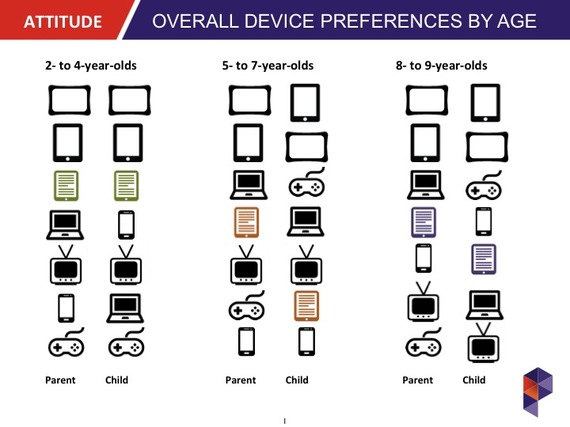I was excited this week when one of my Google Alerts popped up with a link to an infographic on games and gaming, from parents' perspectives. I always love studies about how families are connecting or not through digital media, since we're now well into a time when both parents and children grew up playing video games, making them a generational connector rather than divide. As one gamer cohort raises another, are they finding shared passions and pastimes in strategy, tactics and action, or is that trumped by gaming's evolution from parents playing $50 cartridges on a console to kids "snacking" on freemium games downloaded to a mobile phone? (Clearly, many adults are also casual gamers.)
Either way, I was disappointed to click through to the article and find that it relied on data from 2008 through 2010. Everything, from the breakdown of favorite gaming platforms, to the gender balance, to the parental concerns, to the industry finances, was very much out of date. For context, the most recent study in the graphic was done around the time the iPad debuted, so the statistics didn't reflect - pardon the pun - the biggest "game-changer" around.
The Entertainment Software Association certainly offers more up-to-date insights on its website, so I'm not sure why the infographic and accompanying article dwelt on old numbers.
In any case, the effect of the throwback snapshot to 2010 was to make me think about how compressed time has become in today's world, and the implications for research and strategy.
I'm not a great believer in "KGOY" (Kids Getting Older Younger"), though it's a truism for many in the toy and media worlds. Instead, I hold that most passages of childhood stand unchanged over time: babies, toddlers and kids still go through developmental hallmarks in a predictable order, though with lots of individual variation. It's industry that fosters KGOY by pushing marketing younger; most kids still love the comfortable touchstones of childhood.
At PlayScience, though, we do often write and speak about shorter tech generations, and how they're changing kids' and families' play and learning. The rapid nature of technology innovation is a mashup of Moore's Law with a marketplace ever hungry for the newest gadget. IP owners and content creators are eager to have their brands integrated into all available platforms, in innovative ways. As they've done since the dawn of radio, marketers seek to convince parents that emerging devices are essential to their children's learning. Finally, many parents either buy into the latest device hype (who doesn't want their children to succeed?) or they want the shiniest new toy for themselves and pass down the now hopelessly outdated (but only three-month-old) machine to the kids.
Either way, the result is tighter age cohorts as defined by use of certain device types. PlayScience sees this revealed in our research, whether we're looking into new ways of play, reading or learning. In a global gaming study we conducted a few years back, the children's audience split into three narrow age groups: all kids were still playing using the computer, but 2-5 year olds were more oriented next toward touchscreens, 6-9s split their loyalties between touchscreens and game consoles, and 10-13s had shifted to game-specific devices. More recently, in a 2015 survey of children's platform preferences, all ages now favor tablets, but only the youngest group prefers kid-specific tablets over mainstream ones. The rise and fall of various technologies across very slim age ranges - 2-4, 5-7 and 8-9 - was striking.
The above two examples demonstrate, also, that we need to survey the field more often to track shifts in what devices families own, what they allow children to access, what children themselves own, and how they are using each and all.
Imagine the implications of such time compression on academic researchers and industry producers. Whether conducting a study of media's impact or launching a new set of characters and stories, the entire world can shift beneath your feet if the development process is too long. Today's disruptor is tomorrow's Zune.
Soon, PlayScience will release a new study of the children's VOD market - part parent survey and part analysis and forecast. Even as we prepare the final report, we've had to make constant adjustments, as players and strategies rise and fall (especially in the wake of YouTube Kids).
The industry development and production process is getting more rapid. Streaming video services now serve as a testbed, with audience feedback resulting in popular content getting picked up and expanded by traditional broadcast and cable outlets. Sometimes, the development process is shorter than breakfast to lunch. At a panel in Los Angeles produced by PlayScience, Golin and the Television Academy, YouTuber iJustine described getting up in the morning and asking her 1.75 million Twitter followers what they want to see that day. She'd decide and shoot before lunch and having it online mid-afternoon. Instant analytics shape future content.
While we need new models that respond to the compressed clock and calendar, we also need to be mindful that quality content isn't always instantaneous, nor does it rush to the "hot" technology. Harry Potter wasn't written in a day, and as my friend Josh Selig has said, "no one told Melville, 'great book, but what's the game.'" There's a place in kids' lives for improvised stories but also for big productions that take months or years to write, shoot and edit. Kids love and need diversity in their entertainment just as much as we adults do.
This column appeared originally in Kidscreen.
